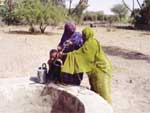


"Desertification is potentially the most threatening ecosystem change impacting livelihoods of the poor. Persistent reduction of ecosystem services as a result of desertification links land degradation in drylands to loss of human well-being."

More people in drylands than in any other ecosystem depend on ecosystem services for their basic needs. Many of the basic resources, such as crops, livestock, fuelwood and construction materials, depend on the growth of plants, which in turn depends on the climate that determines water availability.
Fluctuations in the supply of ecosystem services are normal, especially in drylands, but a persistent reduction in the levels of all services over an extended period constitutes desertification. Dryland people have found ways of coping with periods of scarcity lasting up to several years, but if scarcity lasts too long, at some point their resources and adaptation strategies can be overwhelmed with irreversible consequences. Their capacity to cope with a shortage of services for extended periods can be increased by demographic, economic, and policy factors (such as the ability to migrate to unaffected areas). The amount of time that has passed since the last stress period also influences this capacity to cope.
When a dryland ecosystem is no longer capable to recover from a stress period, a downward spiral of desertification may take place (Figure 1.1). It involves mechanisms such as excessive loss of soil, changes in vegetation, losses in terms of water quality and quantity, and changes in the regional climate system. The intensity and impact of such desertification mechanisms vary from place to place and change over time; depending on the level of aridity and the varying pressure exerted by people on the ecosystem’s resources. Even deserts can degrade further and provide even less ecosystem services, though such hyperarid areas are not covered by the U.N. Convention to Combat Desertification (UNCCD) definition of drylands susceptible to desertification.
Table 1.1. Key Dryland Ecosystem Services
Drylands include many different elements, such as inland waters, human settlements, and cultivated systems, that are all critically linked to desertification processes. Freshwater ecosystems are particularly important for maintaining ecosystem services in dryland areas. Nearly half of the world’s cultivated systems are located in drylands, and thus have a large impact on their landscape. Although cities only account for a small portion of dryland area, they host a large portion of its population.
Understanding how different socioeconomic and biophysical processes interact at a given location over time is critical to understanding desertification. A downward spiral of desertification may occur but is not inevitable (Figure 1.1). While assessment methods to evaluate the extent of desertification using different geographic scales may be sound by themselves, their findings cannot simply be scaled up or down in order to draw conclusions at other levels. More...
Desertification affects all categories of ecosystem services:
These effects can be quantified directly or indirectly and management approaches are available to prevent, reduce, or reverse these manifestations of desertification.
When faced with desertification, people have responded by either increasingly using other low productivity land for cultivation or by converting more rangeland into cultivated land. Since policies to promote alternative livelihoods are usually not in place, people often migrate to other areas, towards cities or even to other countries. These migrations sometimes exacerbate urban sprawl and can bring about socio-political problems.
Conversion of remaining rangelands and forested drylands into croplands and the use of unsustainable cultivation practices increase the pressure on the ecosystem (causing erosion and soil fertility decline) and thus the risk of desertification. Because of overgrazing, in many semiarid areas, there is a progressive shift from grassland (land fully covered by grasses) to shrubland (land covered by scattered bushes) that promotes soil erosion by leaving the topsoil exposed to the wind, which can lead to desertification. More...

This summary is free and ad-free, as is all of our content. You can help us remain free and independant as well as to develop new ways to communicate science by becoming a Patron!